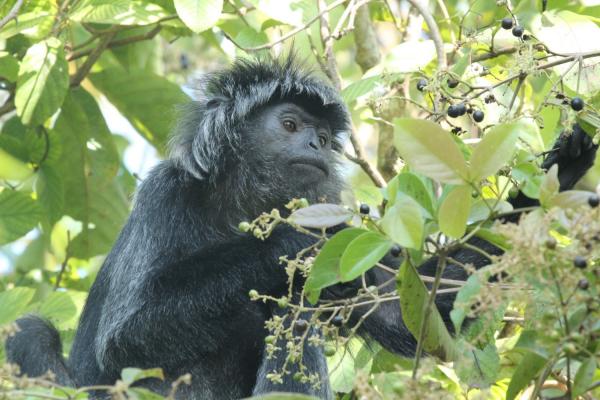



|
TOPICS BONOBO Chimpanzee "Ai" Crania photos Itani Jun'ichiro archives Open datasets for behavioral analysis Guidelines for Care and Use of Nonhuman Primates(pdf) Study material catalogue/database Guideline for field research of non-human primates 2019(pdf) Primate Genome DB 
Primate Research Institute, Kyoto University Copyright (c) |
Japanese Dietary habits of wild Javan lutungs (Trachypithecus auratus) in a secondary-plantation mixed forest: Effects of vegetation composition and
phenology.
Tsuji T., Mitani M., Widayati K.A., Suryobroto B., Watanabe K.
Abstract
This study investigated the seasonal dietary habits of wild Javan lutungs (Trachypithecus auratus) inhabiting the secondary-plantation mixed forest of Pangandaran Nature Reserve, West Java, Indonesia, in relation to vegetation composition and phenology. We conducted behavioral observations of a habituated group for 16 non-consecutive months. The lutungs fed on 164 items (leaf, fruit, flower, etc.) from 85 different plant species. Number of main plant species (>1% usage) was 20, and accumulated percentage of feeding (all plant parts combined) for the top five, 10, and 20 plant species was 43.4%, 63.8%, and 81.2%, respectively. The percentage of feeding on each plant species was positively correlated with the total number of trees and total crown volume. However, selectivity varied; for instance, plant species with a lower crown volume were preferred. The lutungs mainly fed on young leaves (average over the study period, 69.9%), with fruits (both mature and young, 21.2%) contributing more in certain months. The higher percentage of folivory was similar to that found in previous studies for this species and other Trachypithecus species. The category-based analyses revealed a significant positive correlation between the percentage of young fruit and their availability, whereas most other relationships were not significant. The percentage of feeding on young leaves showed a significant negative correlation with the percentage of feeding on mature leaves and dietary diversity, whereas the percentage of feeding on mature leaves had a positive correlation with that of young fruits. Species-based analyses showed that the percentage of feeding on three main diet items had a significant positive relationship with their availability. Our results imply that the dietary composition of the lutungs in our study site is determined by vegetation composition, while the seasonal change in diet is characterized by the availability of main food parts (young leaves and young fruits).  An adult female Javan lutungs (Trachypithecus auratus) eating fruits/seeds of Vitex pubescens.
Bibliographic information
Mammalian Biology Volume 98, September 2019, Pages 80-90 https://doi.org/10.1016/j.mambio.2019.08.001 2019/09/03 Primate Research Institute
|